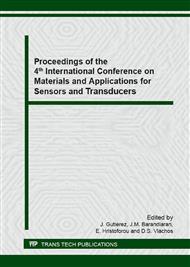p.22
p.26
p.31
p.35
p.40
p.45
p.49
p.53
p.57
Parameters Affecting the Magnetoelectric Response of Magnetostrictive/Piezoelectric Polymer Laminates
Abstract:
Fabrication of magnetoelectric laminates to be used high sensitivity sensors is a critical task and turns out to be influenced by different factors. Among them, the length of the composite (that determines the working frequency of the device) and the epoxy glue characteristics and cure process (that determines the ME signal measured at high temperatures) are of great importance. Here we present results concerning the magnetoelectric response of laminate composites fabricated with an Fe61,6Co16,4Si10,8B11,2 amorphous alloy as the magnetostrictive component and the poly-vinylidene fluoride (PVDF) polymer as the piezoelectric one. Measurements have been performed with composites ranging from 3 cm to 1 cm length and from room temperature up to 100 oC.As observed, an appropriate gluing process between magnetostrictive and piezoelectric components assures the measured magnetoelectric signal to keep constant up to about 60 oC, a temperature where the α-relaxation of the PVDF occurs and the piezoelectric response starts decaying. On the other hand, magnetoelastic resonance (working) frequencies change from 67.5 KHz for the device with L=3 cm to 215 KHz (within the radio-frequency range) for the 1 cm long one. Even for the shortest laminate, we are still able to detect some 6 V/cm.Oe at 100 oC. This makes such laminate composites suitable for high temperature and high frequency applications.
Info:
Periodical:
Pages:
40-44
Citation:
Online since:
May 2015
Price:
Сopyright:
© 2015 Trans Tech Publications Ltd. All Rights Reserved
Share:
Citation:


